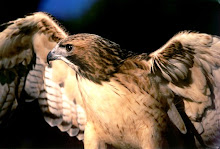 In the wild, animals keep their claws and beaks trimmed down by all the movement they do in the course of everyday living. We clip our dog's nails - most of the time they don't have to go far for food - but wolves, which run for miles, don't need our help in that regard! So, too, our Educational Raptors, which are all unreleasable due to injuries, occasionally need a pedicure!
In the wild, animals keep their claws and beaks trimmed down by all the movement they do in the course of everyday living. We clip our dog's nails - most of the time they don't have to go far for food - but wolves, which run for miles, don't need our help in that regard! So, too, our Educational Raptors, which are all unreleasable due to injuries, occasionally need a pedicure!
Our birds, which are conditioned to stand on a glove, are still wild animals! So a certain amount of wrestling is needed to accomplish this very necessary task. So, out comes the towel, along with a Dremel tool, which does a quick and precise job on overgrown beaks and talons.

Although the birds don't like the initial grabbing, they are remarkably quiet while being "coped", as the trimming is called in the falconry world. Being wrapped in a towel, like a Bird Burrito, is much like using a hood.

After trimming, the slightly ruffled raptors hop back onto the glove. We also weigh them, and it's amazing how quickly they settle down after the ordeal! Of course, just like people, our birds have individual personalities. So our Swainson's Hawk is letting us know he did NOT enjoy that!












